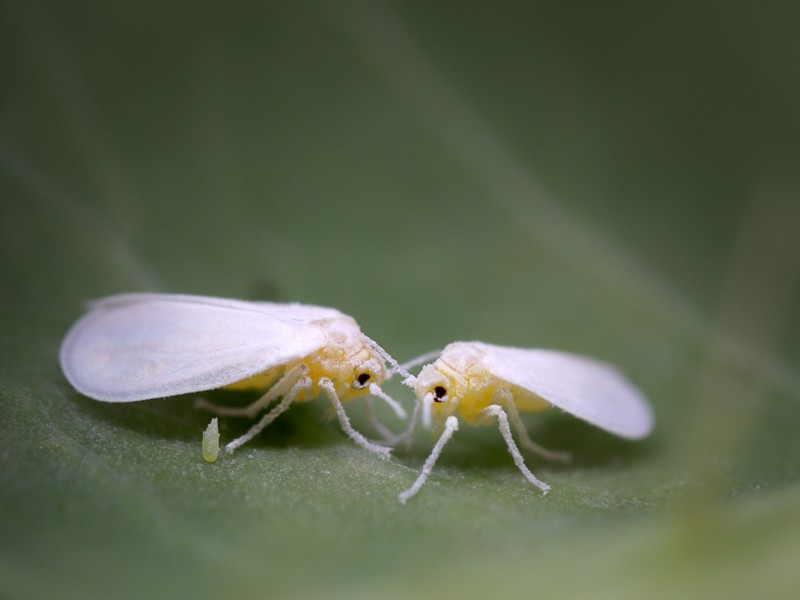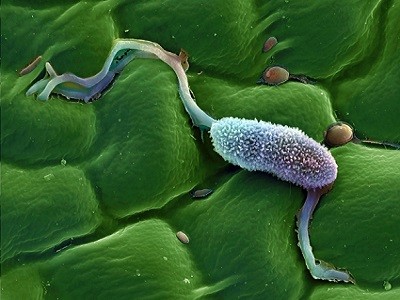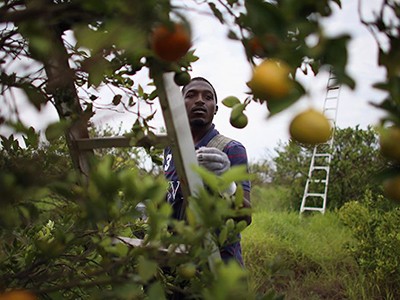A pernicious agricultural pest owes some of its success to a gene pilfered from its plant host millions of years ago.
The finding, reported today in Cell1, is the first known example of a natural gene transfer from a plant to an insect. It also explains one reason why the whitefly Bemisia tabaci is so adept at munching on crops: the gene that it swiped from plants enables it to neutralize a toxin that some plants produce to defend against insects.
Early work suggests that inhibiting this gene can render the whiteflies vulnerable to the toxin, providing a potential route to combating the pest. “This exposes a mechanism through which we can tip the scales back in the plant’s favour,” says Andrew Gloss, who studies plant–pest interactions at the University of Chicago in Illinois. “It’s a remarkable example of how studying evolution can inform new approaches for applications like crop protection.”
The diminutive whitefly — which is more closely related to aphids than to flies — wreaks agricultural havoc around the world. B. tabaci is among the most destructive plant pests: whiteflies sup sugary sap from hundreds of types of plant, all the while excreting a sticky, sweet substance called honeydew that serves as a breeding ground for mould. Whiteflies are also vectors for more than a hundred pathogenic plant viruses.
Stolen genes
That some species of whitefly could owe part of their predatory prowess to genes from other organisms is not entirely surprising, because genetic thievery is common in the arms race between plants and their pests. Over millions of years, plants and insects alike have borrowed heavily from microbial genomes, sometimes using their newly acquired genes to develop defensive or offensive strategies.
Some insects, such as the coffee berry borer (Hypothenemus hampei), have plundered microbial genes to extract more nutrition from hard-to-digest plant cell walls2, and a wild relative of wheat has pilfered a fungal gene to fight off a fungal disease called head blight3. But plants and insects were not known to steal from each other before now.
Entomologist Youjun Zhang at the Chinese Academy of Agricultural Sciences in Beijing and his colleagues were scouring the B. tabaci genome for stolen genes, when they found one that seemed to have evolved not in other insects or microbes, but in plants.
Further study showed that the gene can transfer a chemical group on to defensive compounds called phenolic glucosides. Such compounds are made by many plants, including tomatoes, to ward off pests. But the modification caused by the whitefly gene rendered the compounds harmless.
To test the hypothesis, the team engineered tomato plants to produce a double-stranded RNA molecule capable of shutting down expression of the whitefly gene. Nearly all of the whiteflies that subsequently fed on these doctored tomato plants died.
That result suggests a new means of targeting whiteflies, says Jonathan Gershenzon, a chemical ecologist at the Max Planck Institute for Chemical Ecology in Jena, Germany. “It offers an enormous chance to be specific,” he says. “You could keep the whiteflies away but not harm beneficial insects such as pollinators.”
Plants-pests battle
Gene transfer between species can be difficult to prove, says study co-author Ted Turlings, a chemical ecologist at the University of Neuchâtel in Switzerland. To do so, Zhang, Turlings and their colleagues analysed the sequences of similar genes in plants, and determined that the whitefly gene was their evolutionary kin. The team also carried out analyses to show that the gene was integrated into the whitefly genome, and was not the result of plant DNA contaminating samples.
The results were surprising, but convincing, says Yannick Pauchet, a molecular entomologist also at the Max Planck Institute for Chemical Ecology. “According to the data they provide, horizontal gene transfer is the most parsimonious explanation,” he says.
But how the whitefly managed to swipe a plant gene is unclear. One possibility, says Turlings, is that a virus served as an intermediate, shuttling genetic material from a plant into the whitefly genome.
As researchers sequence more genomes, it’s possible that they’ll uncover more examples of gene transfer between plants and animals, says Gloss.
“Insects taking the genes from the plants themselves is just that last bit of the arsenal that we hadn’t found yet,” he says. “In the battle between plants and their insect pests or pathogens, there are genes being drawn from all over the tree of life.”
"first" - Google News
March 25, 2021 at 10:22PM
https://ift.tt/31gI8qT
First known gene transfer from plant to insect identified - Nature.com
"first" - Google News
https://ift.tt/2QqCv4E
https://ift.tt/3bWWEYd
Bagikan Berita Ini

















0 Response to "First known gene transfer from plant to insect identified - Nature.com"
Post a Comment